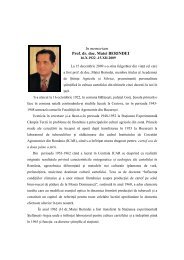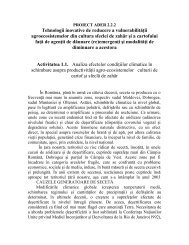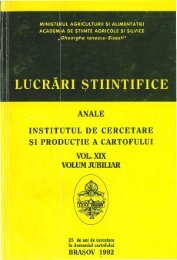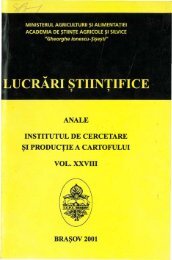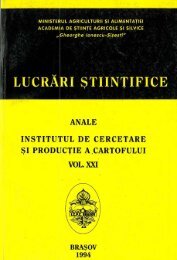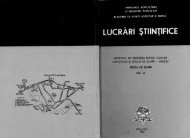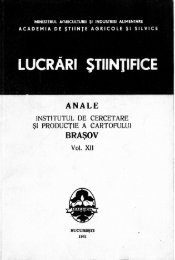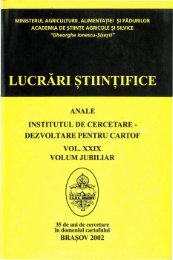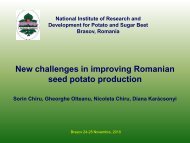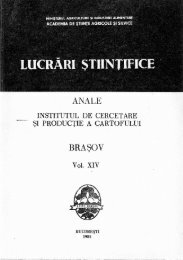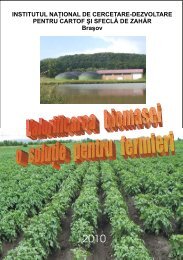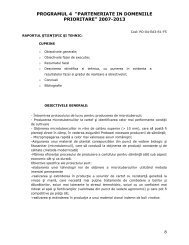anale 8.pdf - Institutul National de Cercetare Dezvoltare pentru ...
anale 8.pdf - Institutul National de Cercetare Dezvoltare pentru ...
anale 8.pdf - Institutul National de Cercetare Dezvoltare pentru ...
- No tags were found...
You also want an ePaper? Increase the reach of your titles
YUMPU automatically turns print PDFs into web optimized ePapers that Google loves.
DIMINUAREA RĂSP!NDIRII VIRUSURILORl 73interiorul culturilor cu reinn1ulţire in masă are o influenţă foarte sen1nificativăasupra reducerii ratei anuale <strong>de</strong> infecţ.ie, în special asupra virusuluiY, la care în cazul neeliminării, infecţiile cresc cu 470/0 după doiani şi cu 241 % după trei ani <strong>de</strong> reînmulţire. (3) Pentru virusul răsuciriifrunzelor, eliminarea surselor inh:~rne <strong>de</strong> infecţie dă diferenţe IUUlt ll1aimici. In acest caz se constată că prin efectuarea <strong>de</strong> 3-5 tratan1ente cuinsectici<strong>de</strong> sistemice, procentul plantelor infectate se reduce semnificativcu 20-80%' (4) Interacţiunea intre efectul eliminării plantelor virozateşictOndiţiile anuale <strong>de</strong> ,cl6.m,ă este foarte semnificativă <strong>pentru</strong> virusul Yşi nUIuai în unii ani este seInnifioaltivă şi <strong>pentru</strong> virusul răsuciriii frunzelor.(5) Din intena'cţiunea complexă între efeatuleumulat al ,anilor <strong>de</strong> re-Înmulţire, condiţjile clinll8.itioe anuale şi elin1i r narea plallitelor virozate seconstată !că in conteXitul 3sanăTii zonelor închise <strong>de</strong> culturi cu peste 10;Q/oinfecţii cu virusuri transluÎsibile prin afi<strong>de</strong>, elim,inării timpurii şi repetatea surselor <strong>de</strong> infecţie din interiorul cultUlrii şi aplii'cării in cOll1plexa celorLalţi faatori tehnologici analizaţi (plantarea la epoca optimă, COffiba,tere-atafi<strong>de</strong>lor vectoa.re), există posibilitatea îlT'J\bunărt:ăţirii !mlaterialului<strong>de</strong> plant;at la toate categoriile biologice produse în zonele închise,inclusiv la categori1a biologică It, al Icărei procent <strong>de</strong> tuherculi infeCltaţ:cu virroze grave se va putea redrUice <strong>de</strong> la 100/0 la 50/0. 'IAceasta ple<strong>de</strong>azăîn favoarea revizuirE standa.rdului <strong>de</strong> stare fitosani:tară al camofului <strong>pentru</strong>sămînţă.Predată Comitetului <strong>de</strong> redacţiela 14 octombrie 1976Referent: ing. N. CojocaruSTUDIES aN DECREASING THE SPREADING OF THE VIRUS YAND LEAFROLL IN paTATO FIELDS FOR SEED PRODUCTIONSUMMARYSeries of po:lifactorial experiments with the variety Desiree (resistant to Y virusand very susceptible ta leafroll virus) weTe carried an in 1969-1974 in Braşov.If in the neighbourhood the1'e is a crop 100/0 infectetd, the infection by the twoviruses i5 incr.easing by 83% aHer one year of seed multiplioation and 123010 afterthree years of seed multiplication (table 1). II the field is well isolated by externalsources of virus infection, the early and repeated rejecting of diseased plants<strong>de</strong>creases the rate of infection especially of virus Y ; if the rejecting is not ma<strong>de</strong>the occumnce of infections increases wHh 47% after two years and 241010 afterthree years (table 2). In the case of leafroll virus occUl''!ance, if the internal sourcesare not discar<strong>de</strong>d the infection rate is not too high ; but if treatments by systemicinsectici<strong>de</strong>s are a.pplied the effect of discarding increases, the rate of infections becoming20-81010 lower in function of the number of treatJ;hents (table 3). Judgingthe complex intJCraction between the cumulated infections·in YOO1'8 of multiplication,the climate of each year (expressed by the <strong>de</strong>velopment of the aphid popu1atio'11s) and discarding the infection sources (for virus Y aud leafroll), after threeycars of multiplkation thc infeetions by both viruses are present 3.89-5.42010 if thcinfection sources are not rejected and· 2.48-3.42% if the infection 80urces areabsent.



